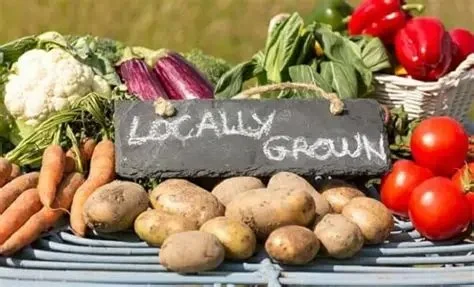
- 1 - The Rise of the Farm-to-Table Philosophy
- 2 - Regional Identity and Local Sourcing Across America
- 3 - The Art of Seasonal Creativity in American Restaurants
- 4 - Notable American Restaurants Championing Local Ingredients
- 5 - Sustainability, Community, and Future Trends
- 6 - Find the Best Seasonal Dining Experiences on Dine Droop
1. The Rise of the Farm-to-Table Philosophy
The concept of “farm-to-table” has transformed the way Americans dine. Once considered a niche culinary movement, it has evolved into a nationwide trend where restaurants prioritize freshness, transparency, and local community engagement. The growing awareness of sustainability and health has driven consumers to seek food that is not only flavorful but also ethically sourced. In this movement, American restaurants emphasizing seasonal and locally sourced ingredients stand out for their authenticity and environmental responsibility.
Many chefs today work directly with local farmers, ranchers, and artisans to ensure the quality of their ingredients. This direct connection creates an ecosystem of trust and craftsmanship—one where diners can taste the difference in every bite. Instead of relying on imported produce or mass-produced ingredients, these restaurants showcase the unique bounty of their region, celebrating nature’s rhythm through their menus.
2. Regional Identity and Local Sourcing Across America
Every region in the United States has its own culinary identity shaped by geography and climate. For example, California’s coastal farms and vineyards inspire menus rich in fresh produce, citrus, and seafood, while the Midwest embraces its heritage of grain-fed meats and root vegetables. New England’s culinary scene shines with seasonal shellfish, maple syrup, and wild blueberries—each telling a story of place and season.
Restaurants that emphasize locally sourced ingredients do more than serve meals—they preserve cultural identity. In the South, chefs reinterpret classics like shrimp and grits using locally milled corn or freshly caught Gulf shrimp. In the Pacific Northwest, restaurants such as those in Portland or Seattle often feature forest-foraged mushrooms, wild salmon, and berries that define the local palate. By supporting regional agriculture, these establishments strengthen local economies while reducing their environmental footprint.
3. The Art of Seasonal Creativity in American Restaurants
Seasonality pushes chefs to think creatively. When a restaurant’s menu changes every few weeks, it challenges the culinary team to innovate with what’s available. For example, a spring menu may highlight asparagus, peas, and tender greens, while autumn dishes embrace squash, apples, and hearty grains. This natural rotation keeps dining experiences fresh and aligns with nature’s own cycles.
Renowned chefs like Alice Waters, who pioneered seasonal cooking at Chez Panisse, have inspired countless others to follow suit. Seasonal cooking not only enhances flavor but also allows diners to develop a deeper appreciation for time and place. A tomato in July, bursting with sweetness, tells a story that canned produce in winter simply cannot. This connection to the seasons transforms dining into an experience rather than a transaction.
4. Notable American Restaurants Championing Local Ingredients
Across the country, several American restaurants have become icons for their commitment to local sourcing. In Brooklyn, Blue Hill at Stone Barns remains a beacon for regenerative agriculture and creative sustainability. The restaurant grows its own produce, raises livestock, and collaborates with nearby farms to minimize waste. Meanwhile, in California, The French Laundry sources from its own gardens, ensuring that every plate represents the peak of seasonal excellence.
In the Midwest, Chicago’s Lula Café has gained recognition for balancing comfort and creativity, with ever-changing seasonal menus that celebrate Illinois farmers. Down South, Husk in Charleston elevates traditional Southern fare by reimagining it with heirloom grains and produce sourced from nearby farms. These examples show that “local” and “luxury” are no longer opposites—they coexist beautifully.
5. Sustainability, Community, and Future Trends
Restaurants that emphasize seasonal and locally sourced ingredients are not only culinary leaders but also sustainability pioneers. They actively reduce food miles, support small-scale farmers, and promote biodiversity through ingredient diversity. Many are now adopting zero-waste cooking techniques, composting food scraps, and replacing imported goods with regional alternatives.
Furthermore, diners are becoming more conscious about the impact of their choices. They seek out establishments that align with their values, creating a demand that drives the entire food industry toward sustainability. As this trend grows, we’re likely to see more collaborations between restaurants, farms, and local markets that prioritize both taste and responsibility.
6. Find the Best Seasonal Dining Experiences on Dine Droop
For those eager to explore the finest American restaurants that embrace seasonal and locally sourced ingredients, Dine Droop is your go-to destination. On Dine Droop, you can discover curated recommendations for restaurants that value freshness, sustainability, and community connection. Whether you’re looking for a cozy farm-to-table bistro in Vermont or a modern urban eatery in Los Angeles, Dine Droop helps you find the perfect dining experience that reflects the authentic spirit of American cuisine.
Eating locally isn’t just a trend—it’s a philosophy that connects us to the land, the seasons, and the people behind every meal. As more restaurants continue to embrace this approach, the American dining landscape will keep evolving—flavor by flavor, season by season.









 Gai Chicken & Rice4.0 (284 reviews)
Gai Chicken & Rice4.0 (284 reviews) Wendy's3.0 (46 reviews)
Wendy's3.0 (46 reviews) Carvel4.0 (64 reviews)
Carvel4.0 (64 reviews) Xi'an Famous Foods 西安名吃 | Downtown Brooklyn4.0 (500 reviews)
Xi'an Famous Foods 西安名吃 | Downtown Brooklyn4.0 (500 reviews) The Best Deli Grocery4.0 (21 reviews)
The Best Deli Grocery4.0 (21 reviews) Poke Time3.0 (12 reviews)
Poke Time3.0 (12 reviews) How Dessert Shops Are Reinventing Classic Treats With Modern Techniques
How Dessert Shops Are Reinventing Classic Treats With Modern Techniques How Brunch Restaurants Are Incorporating Seasonal Produce Into Innovative Dishes
How Brunch Restaurants Are Incorporating Seasonal Produce Into Innovative Dishes How Brazilian Restaurants Are Introducing New Ingredients to Classic Dishes
How Brazilian Restaurants Are Introducing New Ingredients to Classic Dishes Exploring American Restaurants That Focus on Farm-to-Table Ingredients
Exploring American Restaurants That Focus on Farm-to-Table Ingredients Discovering Sushi Restaurants That Focus on Ethical and Sustainable Sourcing
Discovering Sushi Restaurants That Focus on Ethical and Sustainable Sourcing How Brunch Restaurants Are Experimenting With International Fusion Dishes
How Brunch Restaurants Are Experimenting With International Fusion Dishes